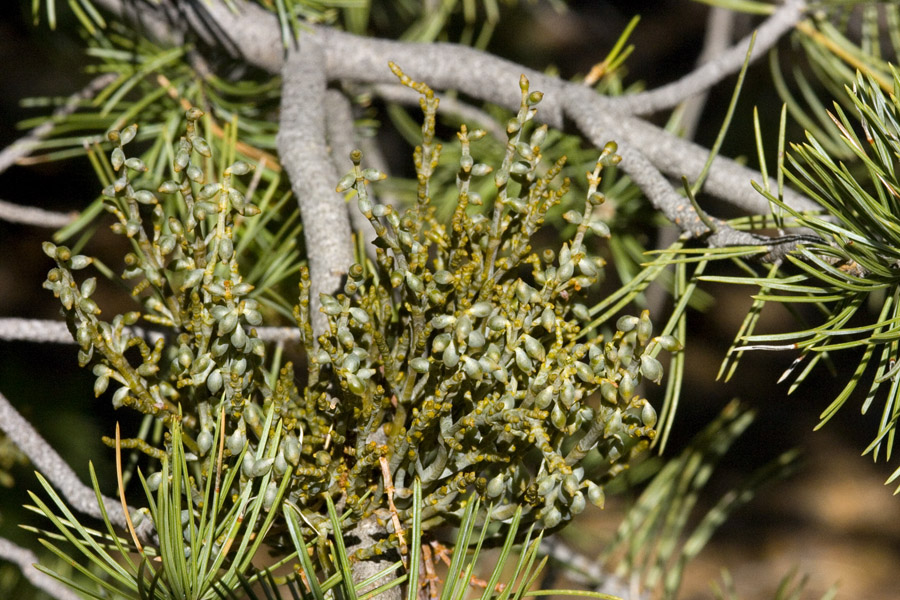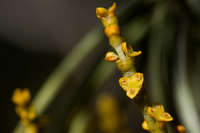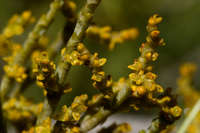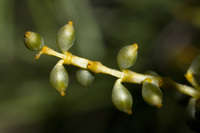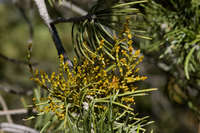|
|
|
|
Family: Santalaceae
pinyon dwarf mistletoe
|
Plant: aerial parasitic shrub; 2-25 cm high, glabrous, dioecious; SHOOTS 7-12 cm high, 2-4 mm wide at base, olive-green to brown Leaves: reduced to minute scales INFLORESCENCE: axillary spikes Flowers: decussate (sometimes whorled), short pedicellate; staminate flowers 2.5 mm in diameter; tepals 3, with a central nectary, the perianth segments (2-)3-4(-5), each segment bearing a sessile, circular, uniloculate anther; pistillate flowers with a single style and rounded stigma, the perianth segments 2, persistent Fruit: 4 mm long, 2.5 mm wide, bicolored, dehiscing explosively (to 15 m); pedicels curved at maturity; SEED without a thickened seed coat, eaten and distributed primarily by birds or dispersed explosively Misc: Pinyon-juniper woodlands; 1400-2400 m (4600-7800 ft); Aug-Sep Notes: HOSTS: pinyon pines, mainly Pinus edulis, but also P. discolor and P. californiarum subsp. fallax REFERENCES: Hawksworth, Frank G. 1994. Viscaceae. J. Ariz. - Nev. Acad. Sci. Volume 27(2), 241-245. Duration: Perennial Nativity: Native Lifeform: Subshrub General: Plants parasitic on pinyon species, mainly on Pinus edulis; host often forms dense, compact witches- brooms. Leaves: na Shoots: Olive-green to brownish, 5-12 cm long, the base 2-4 mm wide; third internode at least 5-7 times as long as wide; branching pattern fan-shaped. Flowers: Solitary, axillary, borne on peduncles 3-15 cm long, the 2 bractlets arising along the middle of the peduncle; sepals lanceolate, 4-7.5 mm long, apex rounded; petals light to deep blue-violet, the lower 3 somewhat whitish towards the base with purple veins, the lateral pair (and sometimes all 5) bearded within near the base, spur petal 14-19 mm long, the spur 2-3 mm long; flowers April-July. Fruits: Berry, ellipsoid to ovoid, 3-4 mm long, 2.5 mm wide, blue-glaucous with a brown apex. Ecology: Pinyon-juniper woodlands; 1400-2400 m (4500-8000 ft); Apache, Coconino, Gila, Graham, Greenlee, Mohave, Navajo, and Yavapai counties; south-central to southwestern U.S., Mexico. Notes: Arceuthobium douglasii (Douglas-fir dwarf mistletoe) is parasitic on Pseudotsuga menziesii; it produces systemic witches- brooms; shoots are scattered all along the host stem near the apex, these olive-green, mostly 0.5-3 cm long, the third internode mostly 3-4 times as long as wide; in staminate flowers perianth lobes are mostly 3, sometimes 4, lobes reddish; pistillate flowers are 1.5 mm wide; flowers May-June. It occurs in mixed conifer forests, essentially in the range of Pseudotsuga menziesii in Arizona. Editor: Springer et al. 2008 |


